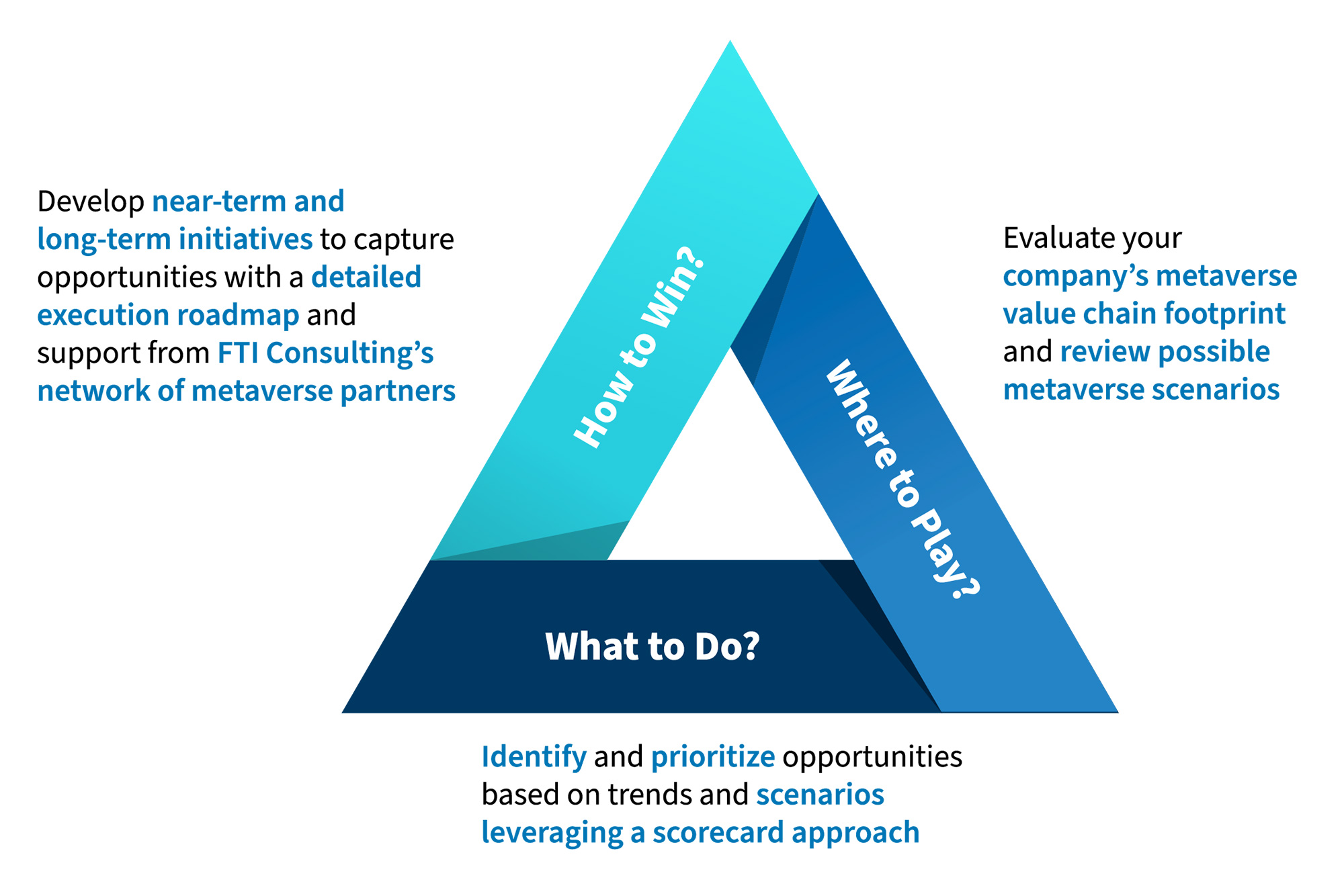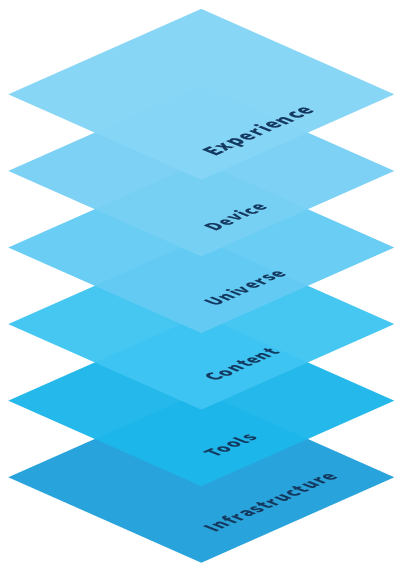- Accueil
- / Publications
- / Articles
- / The Metaverse in Latin America
The Metaverse in Latin America
-
mars 29, 2023
-
In February, Colombia became the first country in South America and one of the first in the world to hold a judicial hearing in the metaverse.1 One month later, Meta and the Colombian government held “Meta Day” in Bogotá to raise awareness around new technologies and launch “Meta Spark,” a platform which trains Colombian entrepreneurs in Augmented Reality (“AR”).2 These events signal an increased focus from the region in the metaverse, and the exciting development of value-adding use cases.
What is the Metaverse?
The metaverse is difficult to define because there is a marked difference between what it is now, and what it is primed to become, and there are many competing opinions of this future vision. According to Mark Zuckerberg (“Zuckerberg”), it is the “embodied internet, where instead of just viewing content – you are in it,”3 whereas for Arthur Madrid, CEO of The Sandbox, the largest metaverse platform by transaction volumes, the metaverse is “to live virtually what you’re living in real life.”4,5
Broadly, the metaverse will form part of the next iteration of the Internet, a 3D version of your computer or smartphone. The idea is to bring what we perceive in the real world into a digital or hybrid space. Rather than browsing information, we will have a virtual identity (avatar) which possesses unique digital assets (NFTs) and can go to different locations – whether that be a virtual office, a classroom, a tourist attraction, a crime scene or an operating table.6 In the words of Satya Nadella, CEO at Microsoft, the aim is to digitize “people, places, and things.”7
The concept is so expansive that it can be useful to break it down into individual layers, as shown in Figure 1. It is a complex space because different companies are developing products at specific layers – for example, blockchain platforms at the infrastructure level, licensed IP at the content level, oculus headsets at the device level, influencers and artists performing at the top level. The metaverse is built upon several technologies such as edge computing, AI, blockchain, 5G, IoT, 3D modeling and extended reality – many of which are still being established.8
And just as we saw companies beginning to develop websites in the late 90s, and social media presences in the late 2000s, business leaders are now beginning to wonder what their metaverse presence – if anything – should be, scoping the potential size of the market and making their first steps into the web 3.0 space.
Figure 1: Layers of the metaverse (source: FTI Consulting)
Hype or the Future?
When Facebook changed its name to Meta in October 2021, the ‘metaverse’ became a household name and there was a flurry of investment and venture capital into the space.9 18 months later, the outlook is very different. Meta has announced thousands of layoffs in the last year and continues to slash its workforce while other tech companies like Microsoft are taking similar measures.10 In the aftermath of the ‘crypto Winter,’ the bankruptcy of FTX and the threat of global recession, access to capital has become more limited and investors are more demanding of immediate commercial value and returns. Analysts are now predicting a ‘metaverse Winter,’ and articles from several news outlets like the Financial Times and Fast Company are all but writing off the sector.11,12
These bearish positions have been solidified by three factors:
- Overestimation: in 2017, Zuckerberg announced his plans to get a billion people into virtual reality. Six years later, there are only an estimated 171 million users worldwide.13,14 Analysis Group has predicted that the metaverse will account for 2.8% of global GDP ($3 trillion) in 2031 if it evolves at the pace of mobile technology.15,16 That’s a big ‘if.’ Exaggeration about how quickly the metaverse would arrive has caused a rift between expectation and reality.
- Zuckerberg’s missteps: several misjudged PR moves have exposed that Meta is out of touch with its audience, eroding trust in sector. Zuckerberg was forced to backtrack after his disappointing metaverse graphic (Figure 2): “I know the photo I posted earlier this week was pretty basic – it was taken very quickly to celebrate a launch.”17
- Initial speculation: Like the “get-rich-quick” schemes in the crypto space and the dot-com bubble in the late 90s, rampant speculation and some reckless gambles have followed the emergence of this new sector. But these market jitters are predictable, and though they have led some to label the space a ‘field of dreams’ (the fallacy of building first before the demand has been proven), they do not detract from the underlying value of the technology.18
As such, the hyped-up interest in the metaverse has cooled somewhat and companies are approaching it with an even temper, more aware of the large initial capital investment and extant gaps in capability and regulation.19 The metaverse is being seen more as a component of a holistic web 3.0 strategy, as companies transition from web 2.0 and emerging technologies are developed for metaverse interoperability.
Nevertheless, we believe that the metaverse will ultimately deliver mass adoption. The general trend of the digitization of societal activities – from Zoom calls to Van Gogh immersive exhibitions and hologram performances of Tupac and ABBA – is pointing in one direction.20,21 But while business to consumer applications may take longer to roll out than first imagined, where we are seeing real value creation is on the enterprise side. Enterprise training programs, customer support teams, recruiting and data visualization are being enhanced with metaverse technology by many providers such as Unity and Talespin.22 Digital twins and B2B applications are used by sectors from financial services to mining – for example, in simulating a large piece of machinery to know how long it will last and where repair teams need to focus, or a virtual emergency room in a hospital to train surgeons.23 As Jensen Huang, CEO of Nvidia, explains, running simulations in the metaverse could save companies billions of dollars in the real world.24

Figure 2: Zuckerberg launches Horizon Worlds in Spain and France, a post which was ridiculed and “memeified” on social media for the quality of its graphics.25 (source: Facebook)
Metaverse in Latin America
Latin America offers specific challenges and use cases when it comes to the metaverse. Underdeveloped network infrastructure and the high cost of technology are major barriers. The metaverse’s aim to ‘democratize’ learning becomes more difficult in a place of limited connectivity and resources, where it is probable that – at first – only a small percentage of the population will have access. However, surveys demonstrate that almost 90% of workers in Brazil, Mexico and Colombia would rather hold meetings in the metaverse than on current platforms, and there are estimates that the sector could contribute up to 5% of Latin America’s GDP by 2031.26,27
Global tech players are taking a stake in the region. In December 2022, Samsung announced that it would spend over $35 million on metaverse projects in Latin America, two months after its Latin American division launched ‘House of SAM’ in Decentraland.28,29 Domestic players are also taking note. Pony Malta and Sajú, two Colombian firms producing beverages and sunglasses respectively, have been among many in launching NFT collections.30 There are many specialized use cases emerging in the continent, among them the following are some of the most exciting:
- Legal Representation: Latin Americans are often forced to travel hundreds of miles to seek justice or be heard in forced displacement cases.31 If network infrastructure and digital literacy improve, the possibility of increasing legal representation virtually, while lowering costs of travel for victims, could be a major benefit.
- Mining Simulation: along with agriculture and oil & gas, mining is one of the main economic industries of Latin America.32 Los Bronces Mine in Chile has deployed simulator-based training since 2015, and, as mentioned above, there is huge potential to increase machine efficiency and reduce risk through digital twins, from the gold mines in Chocó to copper in Arequipa.33
Business Strategy
Many companies are still in the prototyping stage – experimenting with the metaverse and looking for economically viable solutions beyond what is offered by web 2.0. FTI Consulting has been providing market sizing and web 3.0 engagement strategies for these companies, such as designing loyalty models to enhance the creator economy workflow.

Figure 3: Questions that FTI Consulting helps clients to answer (source: FTI Consulting)
In addition, there has been a growing demand for infrastructure solutions through blockchain designs and implementations. By holding immersive workshops, FTI Consulting can showcase the potential of the metaverse to enterprises and create industry-focused use cases, as well as collaborate with an expansive network of partners to identify and execute new business lines for your company – both for near-term opportunities and long-term value creation.
Footnotes:
1: Hannah Perez, “Colombia held its first judicial hearing in the metaverse,” Diario Bitcoin (February 24, 2023), https://www.diariobitcoin.com/paises/sur-america/colombia/colombia-celebra-una-audiencia-judicial-en-el-metaverso/.
2: Laura Suarez, “Meta Day Colombia 2023, a training space for SMEs,” Impactotic (March 3, 2023), https://impactotic.co/meta-day-colombia-2023-un-espacio-de-capacitacionpara-las-pymes/#:~:text=Meta%20realiz%C3%B3%20la%20primera%20capacitaci%C3%B3n,nuevas%20tecnolog%C3%ADas%20para%20sus%20negocios.
3: Ben Egliston, Kate Euphemia, Clark Heemsbergen, and Luke Heemsbergen, “Is the metaverse really the future of work?” GCN (October 24, 2022), https://gcn.com/emergingtech/2022/10/metaverse-really-future-work/378822/.
4: John McLellan, “4 Legal and Regulatory Issues Concerning the Metaverse,” Haldanes (February 2022), https://www.haldanes.com/the-metaverse-legal-and-regulatory-issues/.
5: Lilly Templeton, “Acheval Gets Investment from Cofounder of The Sandbox Metaverse,” WWD (February 22, 2022), https://wwd.com/business-news/business-features/metaverse-acheval-sandbox-sofia-achaval-lucila-sperber-arthur-madrid-investment-1235091761/.
6: Jacquelyn Melinek, “Microsoft CEO: The Metaverse Will Bring Real World into Any Digital Space,” Blockworks (November 2, 2021), https://blockworks.co/news/microsoft-ceo-the-metaverse-will-bring-real-world-into-any-digital-space.
7: “Microsoft connecting people, places via metaverse: Satya Nadella,” The Economic Times (November 3, 2021), https://economictimes.indiatimes.com/tech/technology/microsoft-connecting-people-places-via-metaverse-satya-nadella/articleshow/87502855.cms?from=mdr.
8: Esther Shein, “7 top technologies for metaverse development,” Tech Target (November 18, 2022), https://www.techtarget.com/searchcio/tip/7-top-technologies-for-metaverse-development.
9: “Introducing Meta: A Social Technology Company,” Meta (October 28, 2021), https://about.fb.com/news/2021/10/facebook-company-is-now-meta/.
10: Sarah Frier, Edward Ludlow, and Kurt Wagner, “Meta Plans Thousands More Layoffs as Soon as This Week,” Bloomberg (March 6, 2023), https://www.bloomberg.com/news/articles/2023-03-07/meta-is-said-to-plan-thousands-more-layoffs-as-soon-as-this-week#xj4y7vzkg.
11: Jemima Kelly, “Whatever happened to the metaverse?” Financial Times (February 16, 2023), https://www.ft.com/content/bddec314-3f4c-4296-ae6f-eb2a5328c109.
12: Jesus Diaz, “The metaverse is as dead as Zuckerberg’s cartoon eyes,” Fast Company (August 23, 2022), https://www.fastcompany.com/90781259/the-metaverse-is-as-dead-aszuckerbergs-cartoon-eyes.
13: Kurt Robson, “Meta doesn’t want you to talk about these five things at Connect Conference,” Verdict (October 10, 2022), https://www.verdict.co.uk/meta-doesnt-want-you-to-talk-about-these-five-things-at-connect-conference/.
14: Chris Kolmar, “25+ Amazing Virtual Reality Statistics [2023]: The Future of VR + AR,” Zippia (February 27, 2023), https://www.zippia.com/advice/virtual-reality-statistics/#:~:text=As%20of%202023%2C%20there%20are,171%20million%20VR%20users%20worldwide.
15: Eric Seymour, “New Report Estimates the Metaverse Could Contribute 2.8% to Global GDP in Its First Decade,” Analysis Group (May 16, 2022), https://www.analysisgroup.com/news-and-events/press-releases/new-report-estimates-the-metaverse-could-contribute-2.8-to-global-gdp-in-its-first-decade/.
16: Kurt Robson, “Meta’s Queens of the Metaverse event offered strangely outdated AR technology and hardly any metaverse,” Verdict (September 8, 2022), https://www.verdict.co.uk/metas-queens-of-the-metaverse-event-offered-strangely-outdated-ar-technology-and-hardly-any-metaverse/.
17: zuck, Instagram (August 19, 2022), https://www.instagram.com/p/Chc8I1VBzk6/?utm_source=ig_embed&ig_rid=82871d5a-2930-4f82-875b-b6f30fe4d87a
18: Jesse Felder (@jessefelder), Twitter (February 16, 2023 at 1:08 PM), https://twitter.com/jessefelder/status/1626282485150806016?s=20.
19: “Metaverse frenzy cools as ChatGPT gains steam,” China Daily 9March 8, 2023), http://www.china.org.cn/business/2023-03/08/content_85153040.htm.
20: “The Original Immersive Van Gogh Exhibit Created by Massimiliano Siccardi,” Immersive Van Gogh (last visited March 13, 2023), https://www.immersivevangogh.com/.
21: “The Story of Tupac Shakur’s Hologram at Coachella 2012,” Lollapalooza Mania (January 27, 2018), https://www.lollapaloozamania.com/2018/01/27/la-historia-del-holograma-tupac-debut-coachella/.
22: Deirdre Newman, “How Talespin is using the metaverse to train employees,” The Business Journals (November 22, 2022), https://www.bizjournals.com/losangeles/inno/stories/profiles/2022/11/22/talespin-acquires-adaptive-technology.html.
23: “Simulation Training’s Transition to the Metaverse,” Halldale Group (March 1, 2022), https://www.halldale.com/articles/19460-mst-simulation-trainings-transition-to-themetaverse.
24: Kevin Stankiewicz, “Nvidia CEO says the metaverse could save companies billions of dollars in the real world,” CNBC (November 19, 2021), https://www.cnbc.com/2021/11/19/nvidia-ceo-says-the-metaverse-could-save-companies-billions.html.
25: Name of Facebook User (Mark Zuckerberg), Facebook (August 16, 2022), https://www.facebook.com/photo.php?fbid=10114625396809351&set=a.612287952871&type=3
26:“Latin American Business Professionals Are Ready for the Metaverse,” Business Wire (September 28, 2022), https://www.businesswire.com/news/home/20220928005224/en/Latin-American-Business-Professionals-Are-Ready-for-the-Metaverse
27:Sebastian Osorio Idarraga, “Metaverse Could Contribute 5% to Latin America’s GDP By 2031,” Bloomberg Linea (May 18, 2022), https://www.bloomberglinea.com/2022/05/18/metaverse-could-contribute-5-to-latin-americas-gdp-by-2031/
28:Agne Cimermanaite, “Samsung invests $35 million into its Latin American metaverse initiatives,” Metaverse Post (December 26, 2022), https://mpost.io/samsung-invests-35-million-into-its-latin-american-metaverse-initiatives/
29: “Samsung Launches ‘The House of SAM’ on Decentraland Metaverse,” Binance (October 4, 2022), https://www.binance.com/en/news/flash/7224745.
30: Ana Maria Lugo, “‘CryptoAmor’, the new Pony Malta campaign, by DDB Colombia,” Copublicitarias (February 3, 2022), https://copublicitarias.com/cryptoamor-la-nueva-campana-de-pony-malta-por-ddb-colombia/.
31: Maria Luisa Rodriguez Penaranda, “Colombia: ‘The kings of the world’ and the broken dreams of peace,” Sinpermiso (January 20, 2023), https://www.sinpermiso.info/textos/colombia-los-reyes-del-mundo-y-los-suenos-rotos-de-la-paz
32: “Disorder and caudillismo,” Britannica (last visited March 13, 2023), https://www.britannica.com/place/Latin-America/Disorder-and-caudillismo.
33: “Anglo American Utilizing Immersive Technologies’ Managed Services to Improve Performance at Los Bronces Mine,” Mining.com (November 23, 2015), https://www.mining.com/web/anglo-american-utilizing-immersive-technologies-managed-services-to-improve-performance-at-los-bronces-mine/
Date
mars 29, 2023
 Contacts
Contacts
Associate Director




